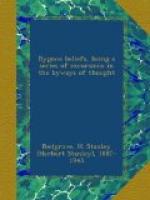[1] The question of PARACELSUS’ pharmacy is further complicated by the fact that this eccentric genius coined many new words (without regard to the principles of etymology) as names for his medicines, and often used the same term to stand for quite different bodies. Some of his disciples maintained that he must not always be understood in a literal sense, in which probably there is an element of truth. See, for instance, A Golden and Blessed Casket of Nature’s Marvels, by BENEDICTUS FIGULUS (trans. by A. E. WAITE, 1893).
[2] See Dr ALFRED C. HADDON’S Magic and Fetishism (1906), p. 15.
[3] HENRY CORNELIUS AGRIPPA: Occult Philosophy, bk. i. chap. xv. (WHITEHEAD’S edition, Chicago, 1898, P. 72).
In modern times homoeopathy—according to which a drug is a cure, if administered in small doses, for that disease whose symptoms it produces, if given in large doses to a healthy person—–seems to bear some resemblance to these old medical theories concerning the curing of like by like. That the system of HAHNEMANN (1755—1843), the founder of homoeopathy, is free from error could be scarcely maintained, but certain recent discoveries in connection with serum-therapy appear to indicate that the last word has not yet been said on the subject, and the formula “like cures like” may still have another lease of life to run.
To return to PARACELSUS, however. It may be thought that his views were not so great an advance on those of GALEN; but whether or not this be the case, his union of chemistry and medicine was of immense benefit to each science, and marked a new era in pharmacy. Even if his theories were highly fantastic, it was he who freed medicine from the shackles of traditionalism, and rendered progress in medical science possible.
I must not conclude these brief notes without some reference to the medical theory of the medicinal efficacy of words. The EBERS papyrus already mentioned gives various formulas which must be pronounced when preparing and when administering a drug; and there is a draught used by the Eastern Jews as a cure for bronchial complaints prepared by writing certain words on a plate, washing them off with wine, and adding three grains of a citron which has been used at the Tabernacle festival. But enough for our present excursion; we must hie us back to the modern world, with its alkaloids, serums, and anti-toxins— another day we will, perhaps, wander again down the by-paths of Medicinal Magic.
NOTE ON THE PARACELSIAN DOCTRINE OF THE MICROCOSM
“Man’s nature,” writes CORNELIUS AGRIPPA, “is the most complete Image of the whole Universe."[1] This theory, especially connected with the name of PARACELSUS, is worthy of more than passing reference; but as the consideration of it leads us from medicine to metaphysics, I have thought it preferable to deal with the subject in a note.




